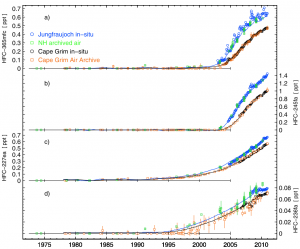Hydrofluorocarbons (HFCs) are replacements for chlorofluorocarbons (CFCs), whose use is being phased out because they are primarily responsible for depleting the ozone layer. While HFCs don’t destroy ozone, they are often very powerful greenhouse gases, so it is important that we monitor their concentration and emissions. One difficulty in doing this is that there are many HFCs emitted into the atmosphere, and new ones are appearing all the time.
To keep track of these gases, my colleagues in the AGAGE network have developed a system that can measure gas concentrations using mass spectrometry. The system is able to detect gases at very low concentrations, by removing most of the nitrogen and oxygen from the measured samples, increasing the concentration of the pollutants they want to measure. This means that we can now detect ‘new’ gases very soon after they appear in the atmosphere.
In this paper, Martin Vollmer from Empa in Switzerland describes the measurement of four HFCs that have appeared in the atmosphere over he last decade or so (HFC-227ea, HFC-236fa, HFC-245fa, HFC-365mfc). Using a combination of in situ measurements, and new measurements of archived air samples, we can determine the entire air history of the four gases, from the year they first appeared in detectable amounts.

Using these observations, and a two-dimensional model of the atmosphere, we calculated the annual global emission rates. As is often the case, the emissions we found differed from inventory estimates by substantial amounts, highlighting the value of these sort of ‘top-down’ verification techniques.
